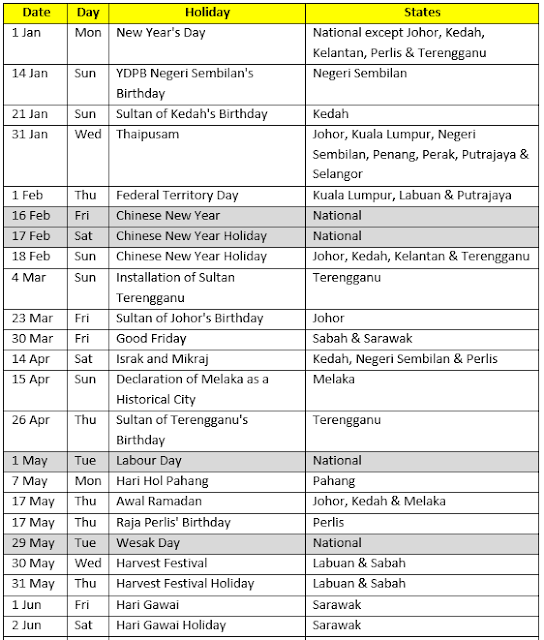Malaysia Public Holidays 2018 (Tarikh Hari Cuti Umum Malaysia 2018)
The Malaysia Public Holidays 2018 Calendar (Jadual Hari Kelepasan Am Persekutuan & Negeri 2018) below is useful for your next holiday trip planning and you have no more excuse not to buy overseas flight tickets during next AirAsia free seats / zero fares promotion.
Malaysia Public / National / Federal Holidays 2018 Calendar (Kalendar Jadual Hari Cuti Kelepasan Am Persekutuan Malaysia)
- February 16 (Friday): Chinese New Year (Tahun Baru Cina)
- February 17 (Saturday): Chinese New Year Second Day (Tahun Baru Cina Hari Kedua)
- May 1 (Tuesday): Labour Day (Hari Pekerja)
- May 29 (Tuesday): Vesak Day (Hari Wesak)
- * June 15 (Friday): Hari Raya Puasa
- * June 16 (Saturday) Hari Raya Puasa (Hari Kedua)
- * August 22 (Wednesday): Cuti Hari Raya Haji / Qurban
- August 31 (Thursday): National Day (Hari Kebangsaan / Merdeka)
- September 9 (Sunday): Agong's Birthday (Hari Keputeraan Seri Paduka Baginda Yang di-Pertuan Agong)
- September 11 (Tuesday): Awal Muharam (Maal Hijrah)
- September 16 (Sunday): Malaysia Day (Hari Malaysia)
- * November 6 (Tuesday): Deepavali (Hari Deepavali)
- November 20 (Tuesday): Prophet Muhammad's Birthday (Hari Keputeraan Nabi Muhammad S.A.W. / Maulidur Rasul)
- December 25 (Tuesday): Christmas (Hari Krismas)
State Holidays 2018 (Jadual Hari Cuti Kelepasan Am Negeri)
- January 1 (Monday): New Year 2018 (Tahun Baru 2018)
- January 14 (Sunday): Yang di-Pertuan Besar Negeri Sembilan's Birthday (Hari Keputeraan Yang di-Pertuan Besar Negeri Sembilan)
- January 21 (Sunday): Sultan of Kedah's Birthday (Hari Keputeraan Sultan Kedah)
- * January 31 (Wednesday): Hari Thaipusam
- February 1 (Thursday): Federal Territory Day (Hari Wilayah Persekutuan)
- February 18 (Sunday): Chinese New Year Replacement Holiday
- March 4 (Sunday): Anniversary of Installation of Sultan of Terengganu (Hari Ulang Tahun Pertabalan Sultan Terengganu)
- March 23 (Friday): Sultan of Johor's Birthday (Hari Keputeraan Sultan Johor)
- March 30 (Friday): Good Friday
- April 14 (Saturday): Israk dan Mikraj
- April 15 (Sunday): Declaration of Malacca as a Historical City (Hari Perisytiharan Melaka Sebagai Bandaraya Bersejarah)
- April 26 (Thursday): Sultan of Terengganu's Birthday (Hari Keputeraan Sultan Terengganu)
- May 7 (Monday): Hari Hol Pahang
- * May 17 (Thursday): Awal Ramadan
- May 17 (Thursday): Raja Perlis' Birthday (Hari Ulang Tahun Keputeraan Raja Perlis)
- May 30 (Wednesday): Harvest Festival (Pesta Kaamatan / Pesta Menuai)
- May 31 (Thursday): Harvest Festival (Pesta Kaamatan / Pesta Menuai)
- June 1 (Friday): Perayaan Hari Gawai Dayak
- June 2 (Saturday): Perayaan Hari Gawai Dayak Holiday
- June 2 (Saturday): Hari Nuzul Al-Quran
- June 17 (Sunday): Hari Raya Aidilfitri Replacement Holiday
- July 7 (Saturday): Georgetown World Heritage City Day (Hari Ulang Tahun Perisytiharan Tapak Warisan Dunia)
- July 14 (Saturday): Penang Governor's Birthday (Hari Jadi Yang di-Pertua Negeri Pulau Pinang)
- July 22 (Sunday): Sarawak Day
- * August 23 (Thursday): Hari Raya Qurban / Haji Hari Kedua
- September 8 (Saturday): Sarawak Governor's Birthday (Hari Jadi Yang di-Pertua Negeri Sarawak)
- September 17 (Monday): Malaysia Day Replacement Holiday
- October 6 (Saturday): Sabah Governor's Birthday (Hari Jadi Yang di-Pertua Negeri Sabah)
- October 12 (Friday): Malacca Governor's Birthday (Hari Jadi Yang di-Pertua Negeri Melaka)
- October 15 (Monday): Hari Hol Almarhum Sultan Iskandar Johor
- October 24 (Wednesday): Sultan of Pahang's Birthday (Hari Keputeraan Sultan Pahang)
- November 2 (Friday): Sultan of Perak's Birthday (Hari Keputeraan Sultan Perak)
- November 11 (Sunday): Sultan of Kelantan's Birthday (Hari Keputeraan Sultan Kelantan)
- November 12 (Sunday): Sultan of Kelantan's Birthday (Hari Keputeraan Sultan Kelantan)
- December 11 (Tuesday): Sultan of Selangor's Birthday (Hari Keputeraan Sultan Selangor)
Kalendar Jadual Hari Kelepasan Am Malaysia 2018 Persekutuan & Negeri
Please take note that Penang Governor's Birthday is on July 14th not 7th.► Read more on Malaysia Public Holidays 2018 Calendar (Kalendar Cuti Umum Hari Kelepasan Am)












